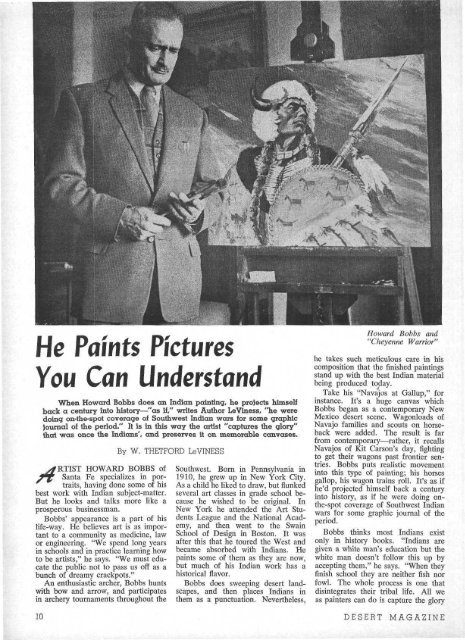Desert Book - Desert Magazine of the Southwest
Desert Book - Desert Magazine of the Southwest
Desert Book - Desert Magazine of the Southwest
You also want an ePaper? Increase the reach of your titles
YUMPU automatically turns print PDFs into web optimized ePapers that Google loves.
He Paints Pictures<br />
You Can Understand<br />
When Howard Bobbs does an Indian painting, he projects himself<br />
back a century into history—"as if," writes Author LeViness, "he were<br />
doing on-<strong>the</strong>-spot coverage <strong>of</strong> <strong>Southwest</strong> Indian wars for some graphic<br />
journal <strong>of</strong> <strong>the</strong> period." It is in this way <strong>the</strong> artist "captures <strong>the</strong> glory"<br />
that was once <strong>the</strong> Indians', and preserves it on memorable canvases.<br />
HOWARD BOBBS <strong>of</strong><br />
Santa Fe specializes in portraits,<br />
having done some <strong>of</strong> his<br />
best work with Indian subject-matter.<br />
But he looks and talks more like a<br />
prosperous businessman.<br />
Bobbs' appearance is a part <strong>of</strong> his<br />
life-way. He believes art is as important<br />
to a community as medicine, law<br />
or engineering. "We spend long years<br />
in schools and in practice learning how<br />
to be artists," he says. "We must educate<br />
<strong>the</strong> public not to pass us <strong>of</strong>f as a<br />
bunch <strong>of</strong> dreamy crackpots."<br />
An enthusiastic archer, Bobbs hunts<br />
with bow and arrow, and participates<br />
in archery tournaments throughout <strong>the</strong><br />
By W. THETFORD LeVINESS<br />
<strong>Southwest</strong>. Born in Pennsylvania in<br />
1910, he grew up in New York City.<br />
As a child he liked to draw, but flunked<br />
several art classes in grade school because<br />
he wished to be original. In<br />
New York he attended <strong>the</strong> Art Students<br />
League and <strong>the</strong> National Academy,<br />
and <strong>the</strong>n went to <strong>the</strong> Swain<br />
School <strong>of</strong> Design in Boston. It was<br />
after this that he toured <strong>the</strong> West and<br />
became absorbed with Indians. He<br />
paints some <strong>of</strong> <strong>the</strong>m as <strong>the</strong>y are now,<br />
but much <strong>of</strong> his Indian work has a<br />
historical flavor.<br />
Bobbs does sweeping desert landscapes,<br />
and <strong>the</strong>n places Indians in<br />
<strong>the</strong>m as a punctuation. Never<strong>the</strong>less,<br />
Howard Bobbs and<br />
"Cheyenne Warrior"<br />
he takes such meticulous care in his<br />
composition that <strong>the</strong> finished paintings<br />
stand up with <strong>the</strong> best Indian material<br />
being produced today.<br />
Take his "Navajos at Gallup," for<br />
instance. It's a huge canvas which<br />
Bobbs began as a contemporary New<br />
Mexico desert scene. Wagonloads oi:<br />
Navajo families and scouts on horseback<br />
were added. The result is far<br />
from contemporary—ra<strong>the</strong>r, it recalls<br />
Navajos <strong>of</strong> Kit Carson's day, fighting<br />
to get <strong>the</strong>ir wagons past frontier sentries.<br />
Bobbs puts realistic movement<br />
into this type <strong>of</strong> painting; his horses<br />
gallop, his wagon trains roll. It's as if<br />
he'd projected himself back a century<br />
into history, as if he were doing on<strong>the</strong>-spot<br />
coverage <strong>of</strong> <strong>Southwest</strong> Indian<br />
wars for some graphic journal <strong>of</strong> <strong>the</strong><br />
period.<br />
Bobbs thinks most Indians exist<br />
only in history books. "Indians are<br />
given a white man's education but <strong>the</strong><br />
white man doesn't follow this up by<br />
accepting <strong>the</strong>m," he says. "When <strong>the</strong>y<br />
finish school <strong>the</strong>y are nei<strong>the</strong>r fish nor<br />
fowl. The whole process is one that<br />
disintegrates <strong>the</strong>ir tribal life. All we<br />
as painters can do is capture <strong>the</strong> glory<br />
10 DESERT MAGAZINE

















